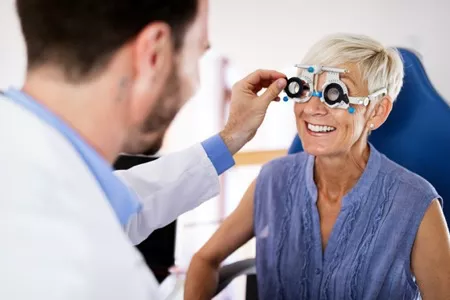November is Diabetic Eye Disease Month. Many people may not realize how easy it is to develop diabetic retinopathy. For many patients, these symptoms are almost unnoticeable and are dismissed as a change in prescription or aging eyes.
According to the Centre for Disease Control and Prevention, more than 30 million Americans suffer from diabetes, diabetic retinopathy is more common than people think. The disease also disproportionately affects Americans with most cases of type 1 and type 2 diabetes affecting racial and ethnic minorities.
Proper vision care and early diagnosis can lead to a significant reduction in the number of cases of diabetic retinopathy. A report by the National Institute of Diabetes and Digestive and Kidney Diseases found that one in three people with diabetes over the age of 40 already had symptoms of diabetic retinopathy.
But this is just one of several eye diseases associated with diabetes. Your eye care professional can help you find the right solutions for your diabetic retinopathy increase treatments and prescription eyewear that can lessen the symptoms.
What Is Diabetic Eye Disease?

With diabetes on the rise in America due to poor diet and lack of access to affordable care, more people are being diagnosed with diabetic eye disease.
Diabetic Retinopathy
The inner lining of the back of the eye is called the retina. It senses light and allows the eye to see. If glucose levels exceed normal, it can lead to damaged blood vessels which can affect the retina’s ability to filter light.
As diabetic retinopathy progresses, patients may experience a weakening or bulge of blood vessels which begin to leak into the retina. This state of diabetic retinopathy is called proliferative diabetic retinopathy and can be difficult to treat, leading to significant vision loss.
Diabetic Macular Edema
Patients who already suffer from diabetic retinopathy may also experience diabetic macular edema. The macula is responsible for reading, driving, and seeing the world around you. As diabetes is left untreated, the macular swells leading to diabetic macular edema. This reduces visual clarity and sharpness. If left untreated, patients may experience vision loss or blindness.
Cataracts
Cataracts are often associated with aging but they can also be the result of poorly managed diabetes. People with diabetes are more likely to develop cataracts at an early age, this may be the result of high glucose deposits around the eyes.
Glaucoma
Glaucoma is another eye disease that most people associate with getting older. This isn’t true, with many people experiencing glaucoma at an early age due to poor diabetes management. Having diabetes increases your chances of developing glaucoma by more than half.
Without proper treatments, these diseases can quickly progress to more serious vision issues including blindness.
There are many effective ways to slow the progression of diabetic eye diseases through simple changes to diet and ensuring your diabetes is properly managed such as checking and maintaining blood sugar levels, losing weight, and lowering blood pressure.
What Are The Symptoms of Diabetic Eye Disease?
Symptoms of diabetic eye disease are very similar to vision loss experienced with age. Patients may not even notice that their eye health is changing as a result of diabetes. The most common symptoms of diabetic eye disease are:
- Changes in vision on a day to day basis
- Blurry
- Floaters which look like spots or dark strings in front of the eyes
- Flashes of light or poor color vision
For most patients, the changes may be short-term as health improves with medical care. If assistance is not sought, then patients may experience swelling in the eyes, significant vision loss, and even blindness.
It is important to monitor blood glucose levels to ensure they stay within an acceptable range. If left untreated, the blood vessels in the backs of the eye can be damaged causing leaking and swelling. This can lead to scar tissue forming causing painful pressure on the eyes.
How Are Diabetic Eye Diseases Diagnosed?

The first step to ensuring good vision is getting a regular eye exam. This allows your eye care professional to do a thorough eye exam and diagnose any potential problems with your eyes. You should see your eye doctor right away if you are experiencing any changes in your vision.
When you arrive for your eye exam, your eyes will be dilated so the doctor can get the best view of the back of your eyes during the examination.
Your doctor will review your medical history to see if anyone else in your family has experienced diabetic eye disease or similar symptoms. If you have a family history of diabetic eye disease you are more likely to develop it too.
The eye doctor will run several tests to diagnose your vision problems including:
Eye Muscle Movement Test
This test examines the alignment of your eyes to see how you can follow a target
Visual Acuity Test
Everyone who has seen the eye doctor has likely had a visual acuity test. This is when the doctor has you ready lines of letters to gauge your vision clarity and depth. It can also determine if you are nearsighted or farsighted.
Refraction Test
Using a computerized refractor, the doctor will go back and forth between different lens prescriptions to determine if glasses will assist with improving your vision concerns.
How To Treat Diabetic Eye Disease?
Once your doctor has completed the eye exam, they will let you know what the next steps should be. Most doctors will recommend improving the management of your diabetes under the guidance of a physician. These steps may include:
- Lowering blood pressure
- Lowering cholesterol
- Quitting smoking
- Improving diet
- Losing weight
In addition to holistic treatments, your eye doctor may also prescribe medicines that treat the symptoms of diabetic eye disease. These include anti-VEGF medicines which prevent the growth of abnormal blood vessels in the eye. They can also help prevent leaks in the eye associated with diabetic macular edema.
Anti-VEGF medicines are injected into the eye using a tiny needle, preceded by a numbing agent. The treatment is painless and patients usually begin to experience improvement in vision loss within a few weeks.
Laser Treatment
Photocoagulation or laser treatments treat leaky blood vessels, called edema. Laser treatments prevent fluid buildup and help reduce vision loss. The two most common types of laser treatment are focal laser treatments which repair small areas of the retina and scatter laser treatments which cover a larger area of the retina. This form of treatment also helps control abnormal blood vessel growth.
Vitrectomy
Patients who are experiencing severe bleeding or scar tissue resulting from proliferative diabetic retinopathy can benefit from vitrectomy. This surgery removes the clear gel in the center of the eye, by using a clear salt solution that is pumped into the eye to maintain pressure during surgery.
Cataract Surgery
Cataract removal is a common and successful surgery for most patients. It involves replacing the lens in the eye with an artificial lens. Most patients will experience a noticeable difference in vision within a couple of weeks of healing. Some patients may require a new prescription for their glasses following cataract surgery.
How To Prevent Vision Loss From Diabetic Eye Disease?
Patients who take steps to improve their health and reduce the symptoms of diabetes are more likely to prevent vision loss due to diabetic eye disease. Though some eye conditions are hereditary, taking the proper steps to improve health and reduce strain on the body can lessen the effects of diabetic eye disease.
A few helpful tips to reduce the effects of diabetic eye disease are:
Get an eye exam - See your eye doctor at least once a year for preventative care and more frequently based on their recommendation. This will ensure any eye problems are diagnosed early and treatment can begin right away.
Improve your health - Work to lower your cholesterol and blood pressure through a good diet and exercise.
Stop smoking - Smoking can cause a host of vision problems from diabetic eye disease to cancer. Talk to your physician to learn about how you can stop smoking for good and protect your eyes from serious damage or blindness.
Web Eye Care can help you find the right pair of glasses to assist in the treatment of your diabetic eye disease. Our glasses offer the highest level of affordable vision clarity so you never have to put money before your health.
We believe in offering our customers the best contact lens and optical lens options to assist with their vision needs. Check out our large selection of glasses, sunglasses, and contact lens options.
 Save yourself from getting into rush hours and buy your contacts online.
Save yourself from getting into rush hours and buy your contacts online.








